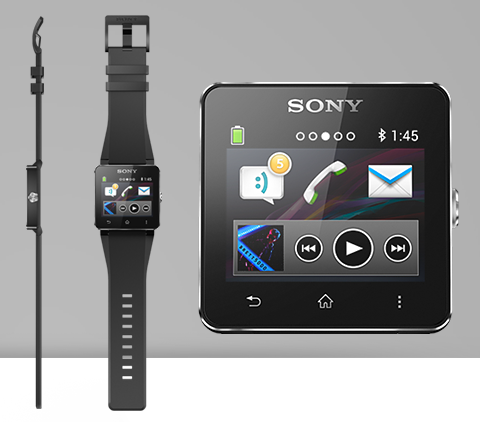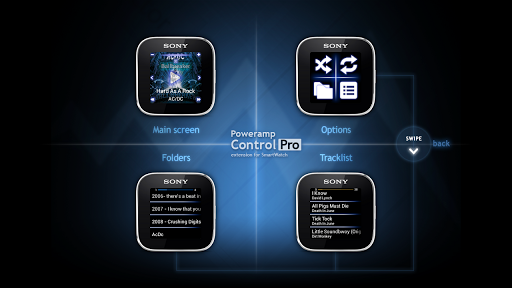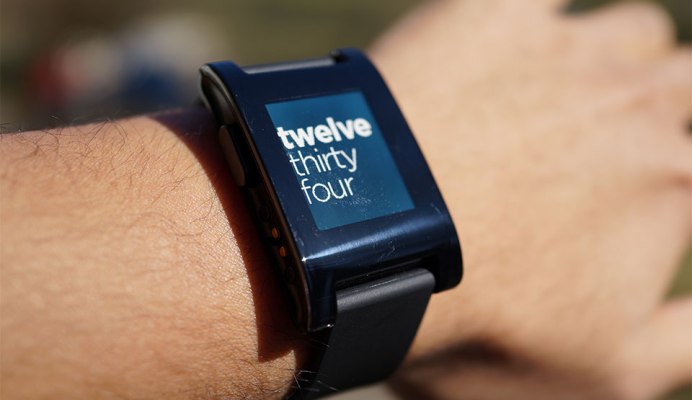Sony’s first go at the smartwatch mostly went unnoticed – a lot of people, myself included, had to be reminded of its existence when the Pebble made big waves for its huge Kickstarter funding success. But Sony’s not letting its early mover advantage go to waste, nor is it letting the SmartWatch brand die on the vine: Today it unveiled the SmartWatch 2, a successor to its original that improves specs and functionality in a number of ways.
The Sony SmartWatch 2 has competition from the aforementioned Pebble, and from fellow Kickstarter success MetaWatch Strata, which is another smartwatch category incumbent. If fact, so is Pebble, which means that this entire generation of devices is actually not the first, but may well be the first with the chance to actually gain some traction with the wider consumer market. Accordingly, a tale of the tape is definitely in order.
Platform support
Both the Pebble and the MetaWatch win this round, as they support both iOS and Android, while the SmartWatch 2 only works with Android phones. Sony has improved on the previous generation thanks to opening up support for any Android phones, instead of just Xperia devices, which makes this about 1000x more useful. And while the other devices support iPhone, there are limits put in place by the platform that make using smartwatches with iOS far less useful, though many of those are on track to change with iOS 7, which, for example, brings support for third-party app notifications to Pebble.
Battery
![]() Battery life is going to be key to any kind of wide smartwatch adoption, and both Pebble and MetaWatch highlighted their multi-day power capabilities ahead of their device launches. Pebble says it can keep the watch powered for over a week on a single charge, and MetaWatch says its Strata will run for 5 to 7 days on a single charge – in practice, I’ve found both to be at the low end of their estimates, and the Pebble slightly under on some cycles.
Battery life is going to be key to any kind of wide smartwatch adoption, and both Pebble and MetaWatch highlighted their multi-day power capabilities ahead of their device launches. Pebble says it can keep the watch powered for over a week on a single charge, and MetaWatch says its Strata will run for 5 to 7 days on a single charge – in practice, I’ve found both to be at the low end of their estimates, and the Pebble slightly under on some cycles.
Sony’s new watch makes some specific claims about its battery life, as well as making the biggest claim of all: The SmartWatch 2 has the “longest battery time for a smartwatch,” Sony says in its press release, a stat which it says has been verified by Strategy Analytics as of June 21, 2013. But the listed battery time expectations fall under those listed by its competitors; Sony claims 5 to 6 days with low usage, and 3 to 4 days with “typical” use. Testing standards may differ, but it looks like this will be right in the same general area as the competition when it comes to battery life overall, so don’t expect anyone to have a real distinct edge here.
Connectivity
The Pebble uses Bluetooth 2.1+EDR, as well as 4.0 Low Energy (LE) to connect to your device, which gives it some extra notification magic on iOS, while the MetaWatch Strata has Bluetooth 4.0 only. Sony’s SmartWatch 2 uses Bluetooth 3.0, which is interesting since it also claims the longest battery life without Bluetooth LE and with a much larger, color screen. The SmartWatch 2 also offers NFC, a trick neither of its competitors has, which does little beyond simplify the pairing process. Still, it’s an added convenience for users with NFC in their smartphones, and shouldn’t be discounted.
Display
 SmartWatch 2 is the only one in the crop with a color display, boasting a 1.6-inch 220 x 176 pixel screen. The Pebble has a 144 x 168, 1.26-inch display, and the MetaWatch Strata has a 96×96-inch screen, which is 1.16-inches. The screens are all close, but there are key differences that users will want to consider. Both the Strata and the Pebble offer a nightlight LED for illumination, but lack any backlighting. This helps with power, but the Sony SmartWatch 2 with its colour display will be more legible in dark environments.
SmartWatch 2 is the only one in the crop with a color display, boasting a 1.6-inch 220 x 176 pixel screen. The Pebble has a 144 x 168, 1.26-inch display, and the MetaWatch Strata has a 96×96-inch screen, which is 1.16-inches. The screens are all close, but there are key differences that users will want to consider. Both the Strata and the Pebble offer a nightlight LED for illumination, but lack any backlighting. This helps with power, but the Sony SmartWatch 2 with its colour display will be more legible in dark environments.
The MetaWatch Strata uses a reflective surface as the base for its screen, which results in it being virtually unreadable in certain lighting conditions, but the Pebble is mostly very legible, though the environmental light level detector is hit or miss. Sony claims that its colour display will be sunlight-readable, but generally speaking an e-ink screen like the one in the Pebble should fare better in that kind of environment.
Water resistance
The SmartWatch 2 is “splash-proof,” but that basically seems to mean you can wear it in a light rain shower or while washing your hands. Sony says not to wear it while showering, bathing, swimming, diving, snorkeling, fishing or doing “water related work.” Also, it notes that the watchband it ships with is neither water- nor splashproof. Basically, you can get it wet – but don’t get it wet.
The Pebble offers water resistance to up to 5 ATM, in both salt- and freshwater, which means you can take it swimming, or run in the rain. Pebble says not to use the watch in hot water, or while diving. The Strata likewise is rated to 5 ATM, or a submersion death of 165 feet. Both the existing devices win out in this category, for sure.
Apps
The Pebble has an API that’s being used by developers to build apps, but apps are coming relatively slowly, and offer fairly limited functionality. No doubt we’ll see more, but out of the box, the Pebble offers little beyond watch faces, notifications, and controls for your on-device music playback. MetaWatch does notifications, but email, calendar, Facebook and Twitter are still “coming soon” and there’s no word on third-party apps. The Strata does do music controls, and has weather, stock and calendar widgets, as well as an out-of-range alert so you don’t leave your phone behind.
 The SmartWatch 2 offers call handling on the device (as does the Pebble) as well as a call log, notifications for calls, email, Gmail, Facebook, Twitter, and more. It does music remote functions, and offers calendar, weather, runtastic and new events aggregation. That’s out of the box, and there’s more planned. You can also remotely snap photos from your SmartWatch, control presentations and more using SmartWatch applications created by developers. Sony might have the edge in terms of app features, if only because it has more clout to convince and sign up developers.
The SmartWatch 2 offers call handling on the device (as does the Pebble) as well as a call log, notifications for calls, email, Gmail, Facebook, Twitter, and more. It does music remote functions, and offers calendar, weather, runtastic and new events aggregation. That’s out of the box, and there’s more planned. You can also remotely snap photos from your SmartWatch, control presentations and more using SmartWatch applications created by developers. Sony might have the edge in terms of app features, if only because it has more clout to convince and sign up developers.
Charging
It’s a small thing, but really important: the SmartWatch 2 uses micro USB to charge, while both the Pebble and the MetaWatch Strata use proprietary cables. That means added expense should you lose the single cable they ship with, and just general inconvenience. Sony definitely comes out ahead here.
Bottom Line
I don’t know if any of these smartwatches will be the one to break the mass market; more than likely, they won’t. But they show an evolution, and Sony’s at least trying to do better than the last time out, and has also clearly learned from the progress of its upstart rivals at Pebble and MetaWatch. Anyone other than early adopters might still want to hold off until OEMs devote and platform makers make more of an effort to actually support smartwatches, but at this point at least you won’t be in for an entirely frustrating experience if you pick one up.
